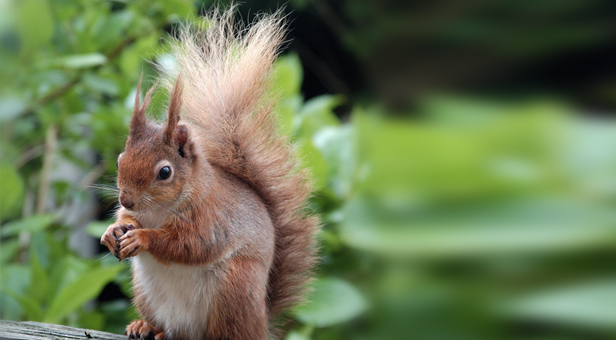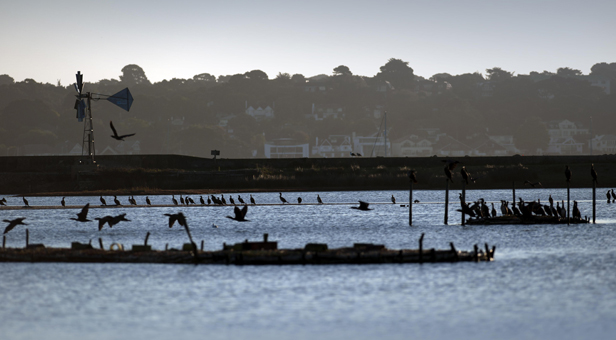As birdwatchers and other visitors prepare to take up the chance of a rare winter visit to Brownsea Island, the National Trust owned property has just been declared the country’s favourite nature reserve.
The island in Poole Harbour was nominated for the award by the BBC’s Countryfile Magazine and came out top of a public poll.
It was up against stiff competition from the likes of the RSPB’s Ouse Fen in Cambridgeshire, the Farne Islands in Northumberland and the Bass Rock, Scottish Seabird Centre in East Lothian.
“We thought it was great that the nature writer Mark Cocker and presenter of the BBC’s Big Wildlife Revival Ellie Harrison has selected Brownsea Island to be in the shortlist but to come out top and win the award shows just how many people really love Brownsea,” said Angela Cott, the National Trust’s General Manager for the island.
“It is a really special place with over-wintering birds in the lagoon, red squirrels thriving in the pine woodlands and a wide range wildlife now making the island their home. We have been working hard over the winter to make Brownsea even better, improving wildlife habitats and we are also opening on winter weekends so people can come and see what makes the island so special.”
For the last 50 years since Brownsea was opened to the public, Dorset Wildlife Trust (DWT) has managed its nature reserve on the island.
DWT Reserve Manager, Chris Thain said, “We are absolutely delighted to have been selected for this award.
Winter is a particularly spectacular time to come to the Lagoon and see not only a huge diversity of birds, but also in large numbers.
In January this year, we have counted 1,973 black tailed godwits and 1,181 avocets.
The Lagoon is vitally important to over wintering wildfowl and waders, and the flocks of birds are a very impressive sight – especially if you’re a keen photographer.”
The National Trust is opening the island on weekends from 8 February until 16 March, 10am-4pm, allowing birdwatchers and other visitors to be able to make a rare winter trip to Brownsea and then from 22 March the island will be open every day until 2 November 2014.
The ferry to the island during these weekends will operate every 30 minutes from Sandbanks with the cost of the boat and entrance to the island payable on arrival at Brownsea.
There has been work carried out to tidy up after the New Year storms which caused some damage to trees, including the loss of a 17th century oak tree – the third oldest on the island.
More information is available on www.nationaltrust.org.uk/brownsea
Other Nature Reserves shortlisted for the Countryfile Magazine awards were
· Sherwood Forest NNR, Nottinghamshire
This fragment of world-famous woodland includes 900 ancient oaks and the magnificent Major Oak.
This fragment of world-famous woodland includes 900 ancient oaks and the magnificent Major Oak.
· St Kilda, Outer Hebrides
These islands rise out of the Atlantic with sublime drama and are packed with tens of thousands of seabirds.
These islands rise out of the Atlantic with sublime drama and are packed with tens of thousands of seabirds.
· Dove Dale
This may be one of the busiest spots in the Peak District, but how can you resist this glorious, flower-rich reserve?
This may be one of the busiest spots in the Peak District, but how can you resist this glorious, flower-rich reserve?
· Ouse Fen RSPB, Cambridgeshire
A vast wetland habitat project, but it already has so many birds that it gives you hope for the future.
A vast wetland habitat project, but it already has so many birds that it gives you hope for the future.
· Horsey Mere, National Trust
Reedbeds, vast sky-scape and the promise of the unexpected.
Reedbeds, vast sky-scape and the promise of the unexpected.
· Arundel WWT, West Sussex
Tranquil wetlands overlooked by Arundel Castle, famed for its water voles. Also reed and sedge warblers.
Tranquil wetlands overlooked by Arundel Castle, famed for its water voles. Also reed and sedge warblers.
· Brownsea Island, National Trust, Dorset
A diversity of habitats: sheltered lagoon, flooded woodland and pine wood. Home to red squirrels.
A diversity of habitats: sheltered lagoon, flooded woodland and pine wood. Home to red squirrels.
· Bass Rock, Scottish Seabird Centre, East Lothian
The spot to see gannets, with 150,000 in peak season. Many other seabirds, too.
The spot to see gannets, with 150,000 in peak season. Many other seabirds, too.
· Farne Islands, National Trust
Accessed by boat, see seals, puffins and Arctic terns up close.
Accessed by boat, see seals, puffins and Arctic terns up close.
· Murlough, National Trust, Co Down
A sand dune system on the edge of the Mourne Mountains, the place for seals and butterflies.
A sand dune system on the edge of the Mourne Mountains, the place for seals and butterflies.








